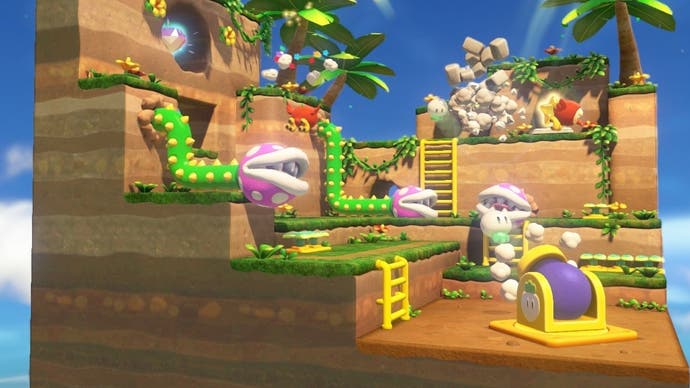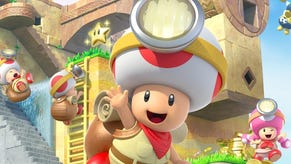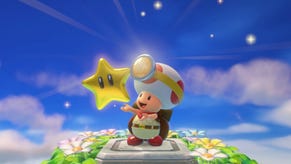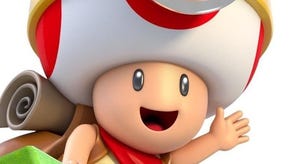Captain Toad: Treasure Tracker and the pleasures of a secondary objective
Nintendo's anti-platformer remains a quirky joy.
One of the loveliest thoughts about games that I have read in ages came - and this was not surprising to me - from Tom Senior, the online editor of PC Gamer. "I feel like we should run Into the Breach scenarios in PC Gamer like newspaper Chess puzzles," he wrote. "ie. "Two mechs are webbed in a tide zone. Save both and protect the factory.""
I read that and thought: of course! Into the Breach is a wonderfully compact turn-based tactics game that plays out on a small grid. You keep waiting for the grid to get bigger as you play, but thankfully it stays the same size throughout, while your growing understanding of the game and its pieces means your options get richer instead. It would work gloriously in the back pages of a newspaper, in alongside a chess problem and a Sudoku. It is hard for me to play it these days without imagining its ideal form, a la Senior, rendered in smudged newsprint, to be toyed with over the course of a morning commute.
Captain Toad: Treasure Tracker stirs the same kind of thoughts in me, even though it's nowhere near as tidy a fit. I missed this wonderful anti-platforming platform game when it arrived on Wii U, so it's a delight to be able to catch up with it on Switch. Captain Toad sees you exploring a chunk of Mushroom Kingdom territory, nominally searching for the gold star located in each level, but really just exploring and tinkering with things. Mario games have been feeling like little pieces of nursery sculpture for a long time: they are chunky and have pleasantly rounded edges, and they delight in materials such as shiny plastic, smoothly-planed wood and sponge (or is it sponge cake?).
Captain Toad really zooms in close on this. You move the landscape as much as you move the camera while Toad wanders around the place. Some levels sprawl, but the best are neat little cubes of terrain filled with interesting gaps. The challenge, I think, is twofold: find out where you want to get to and then find out how to get there. I say find out rather than work out for that last part because, although these are puzzley games, they seem to delight, in a particularly Nintendo way, with the act of discovery through interaction. Sure, you can think your way to a solution, but it's much more in keeping with the vibe, I think, to proceed by prodding and poking and wandering about.
I can see this in newsprint, I reckon, even though it wouldn't really work. This is one of the more 3D-centric games ever created, since it's about manipulating a thing, a band-sawed block of stuff. It would not make much sense in two dimensions. Or would it? Because as I've been playing on Switch I've started to suspect that the part of the game that I'm really enjoying is one layer removed from the moment-to-moment action anyway.
Captain Toad's campaign unfolds as a series of levels, each one given its own theme and its own challenges. But once you've found the gold star - and once completionists have found the three gems hidden about each level - there's still something else to do. Each level has its own secondary objective, and this secondary objective only becomes clear once you have completed the primary objective and headed back to the menu. At this point, you get to see a twist: collect a certain number of coins, find a golden mushroom hidden somewhere, that kind of thing.
I have found myself, while playing, unable to stop thinking about these secondary objectives. In fact, the secondary objectives have totally taken over. And the puzzle, for me, the defining puzzle of each level, is now simple: I want to work out what the secondary objective is and achieve it before I have completed my first runthrough and had the mystery revealed.
So a level with platforms that move up and down, say - lovely stuff in their own right, and I adore the surprising tinkly sound they produce as Toad races over them, as if they were made from finest crystal. But what I'm really thinking when I see them in a level is: play economically! I bet the secondary objective here is to get to the gold star without moving these platforms too much. Equally, when I see enemies, I wonder if the secondary objective is to defeat them all or - much harder - to defeat none of them.
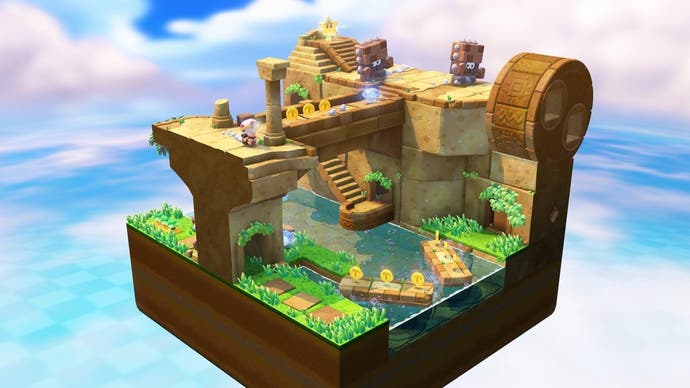
This is the bit you could stick in the newspaper, I reckon. Here's the level, guess the secondary objective. And while that's unlikely to happen any time soon - I hope Into the Breach makes it into G2 far sooner, frankly - it's interesting to think that secondary objectives are having a bit of a moment right now. Fortnite's Battle Pass is the supreme example. In a game with a very clear primary objective, I am suddenly dropping into the map to spraypaint signs, to fall through hoops, to follow treasure maps. All of this stuff enlivened not just by the things I am unlocking, but by the fact that these objectives are layered across the game - they run against the primary objective but must also live with that objective.
And with all secondary objectives there is the attendant pleasure of letting them go. My favourite level in Captain Toad so far comes quite early on in the campaign. I'm thrown into a world that is made of dark-panelled bookcases. The whole place is like some Escher-esque twist on an old study. I mess around and discover I can rotate the stacks of books to open up new areas and new paths. The whole thing is so compact but so tricksy.
I may love a secondary objective, but there is a very special place in my heart for a trick bookcase. Give me a trick bookcase and I'm anybody's. And so Captain Toad draws me back to its heart with another layer of complexity. I don't know how Nintendo does it.
